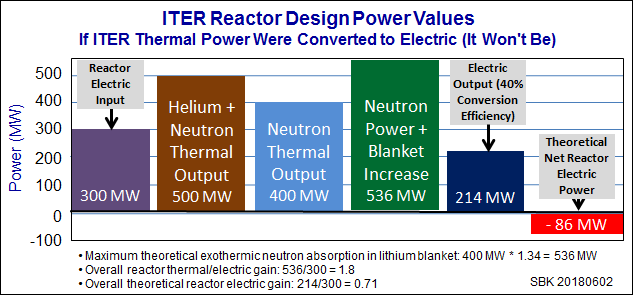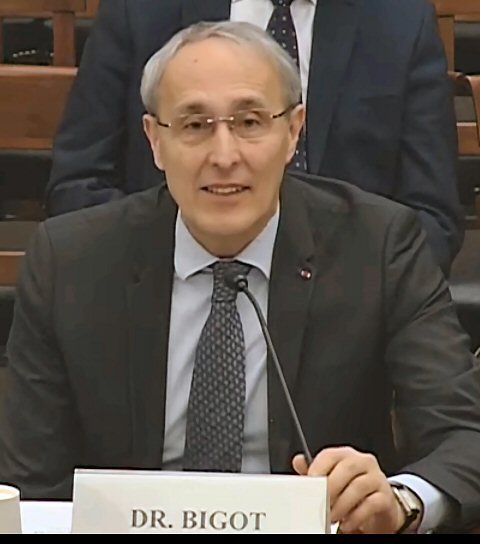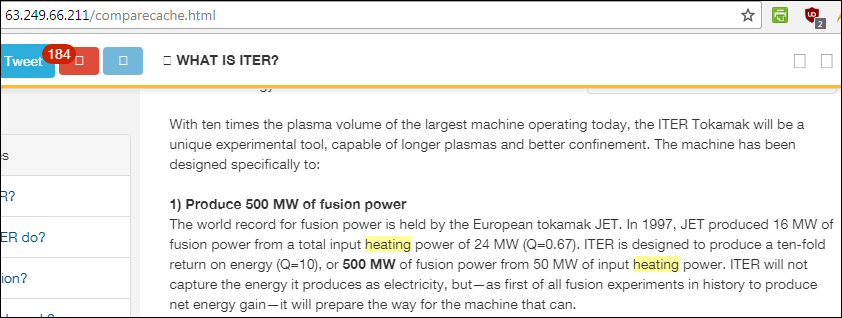Complete List of All Reports in This Series
By Steven B. Krivit — March 28, 2018
At 10 a.m. on March 6, the House Subcommittee on Energy convened a hearing on the future of U.S. fusion eneeffrgy research. After the witnesses spoke, Dana Rohrabacher (R-CA) questioned them. He asked James W. Van Dam, the acting associate director of the Department of Energy’s Office of Fusion Energy Sciences, for physical evidence of practical man-made fusion energy.
“Have we had any actual realization at all, of something other than the computer models that suggests that we’re going to get there? Have we had an ignition of fusion? Man-made fusion energy?” Rohrabacher asked.
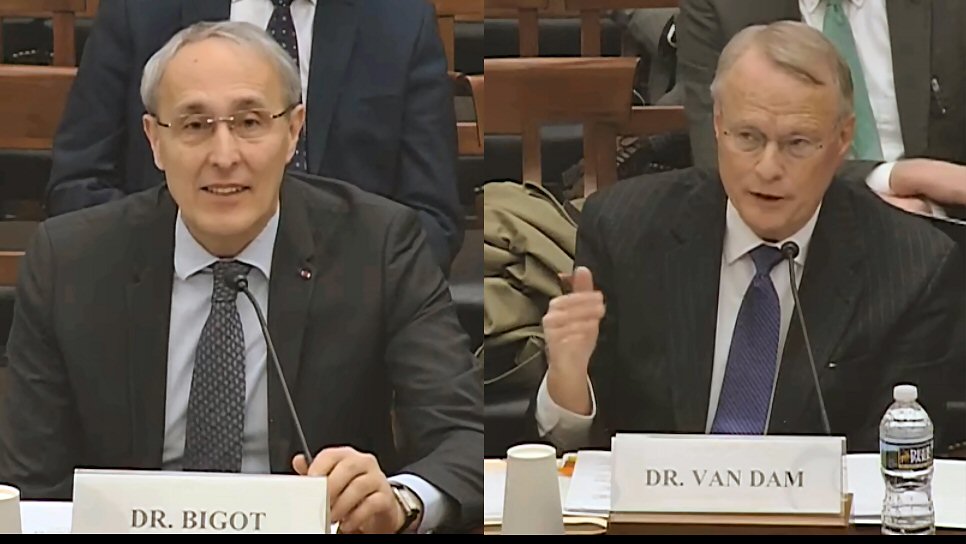
Bernard Bigot and James Van Dam. Click here for link to video excerpt, source, and transcript from March 6, 2018, House Subcommittee on Energy Hearing – “The Future of U.S. Fusion Energy Research”
“Well, there are two examples: one in the U.S., one in Europe,” Van Dam said. “The U.S. example was the TFTR tokamak at Princeton in the late 1990s, and they got very close to breakeven. The Joint European Torus [JET], likewise, around the same time, got even closer.”
“Very close” did not satisfy Rohrabacher, and Van Dam responded defensively, “Well, those were still smaller machines.”
Rohrabacher invited the second witness, Bernard Bigot, to respond to his question. Bigot is the director-general of the organization building the $22 billion International Thermonuclear Experimental Reactor, known as ITER. Bigot presented his argument:
At JET, we know it could not deliver more than 70 percent of the fusion power it received. Because of the size, it is not possible to have net fusion power. We had fusion power, but not a net outcome. This is why, with ITER, we need a larger tokamak, a larger vacuum vessel, and the expectation is to have 10 times the fusion power that we will feed in with the heating system — 500 megawatts of fusion power. So everybody in this audience has to understand there is a minimum size if you want to get fusion power.
Bigot failed to explain that his last use of the phrase “fusion power” meant something entirely different from his other uses of the phrase “fusion power.” Fusion representatives have been using this dual meaning to their advantage — without defining it — when speaking with elected officials and members of the news media (and thus to the public) for decades.
One meaning, commonly understood by the public, signifies usable net thermal output from a fusion reactor that, theoretically, could be converted to practical electrical power. The corollary phrases are solar power, wind power, or nuclear fission power. These phrases normally indicate practical, usable net power output levels from each type of system.
The other meaning of “fusion power” signifies gross thermal output. Whereas net thermal output takes into account the electrical input power expended by the reactor, and gives a realistic measure for system performance, gross output does not. Gross thermal output excludes the power that is required to operate the fusion reactor and provides no meaningful measure of overall system performance.
The nuclear fusion research community is fully aware of both meanings. Based on my review of the messages received by the general public, news media, and elected officials about fusion results, they are generally not aware that two meanings exist in the context of nuclear fusion claims.
As a matter of practice, fusion researchers never talk about the electrical power required to operate fusion reactors because they know that experimental fusion reactors have never approached output levels where net thermal output would be meaningful or relevant. But their representatives tell the public, the news media, and elected officials a different story.
Neither Van Dam nor Bigot explained that the numbers each had just given to the committee signified gross thermal output. In the absence of this material disclosure, only a nuclear fusion expert would have correctly understood the values given by the two fusion experts.
Because Rohrabacher was not a nuclear fusion expert and was asking how close experimental fusion reactors had come to demonstrating practical, usable power, he could not have cared about the gross thermal power value; he wanted to know the net thermal power value.
As it turns out, the Tokamak Fusion Test Reactor (TFTR) at the Department of Energy’s Princeton Plasma Physics Laboratory, on one of the campuses of Princeton University, didn’t come “very close,” as Van Dam said, to making as much power as it consumed. Neither did the Joint European Torus (JET) in the U.K., as the graph below shows.
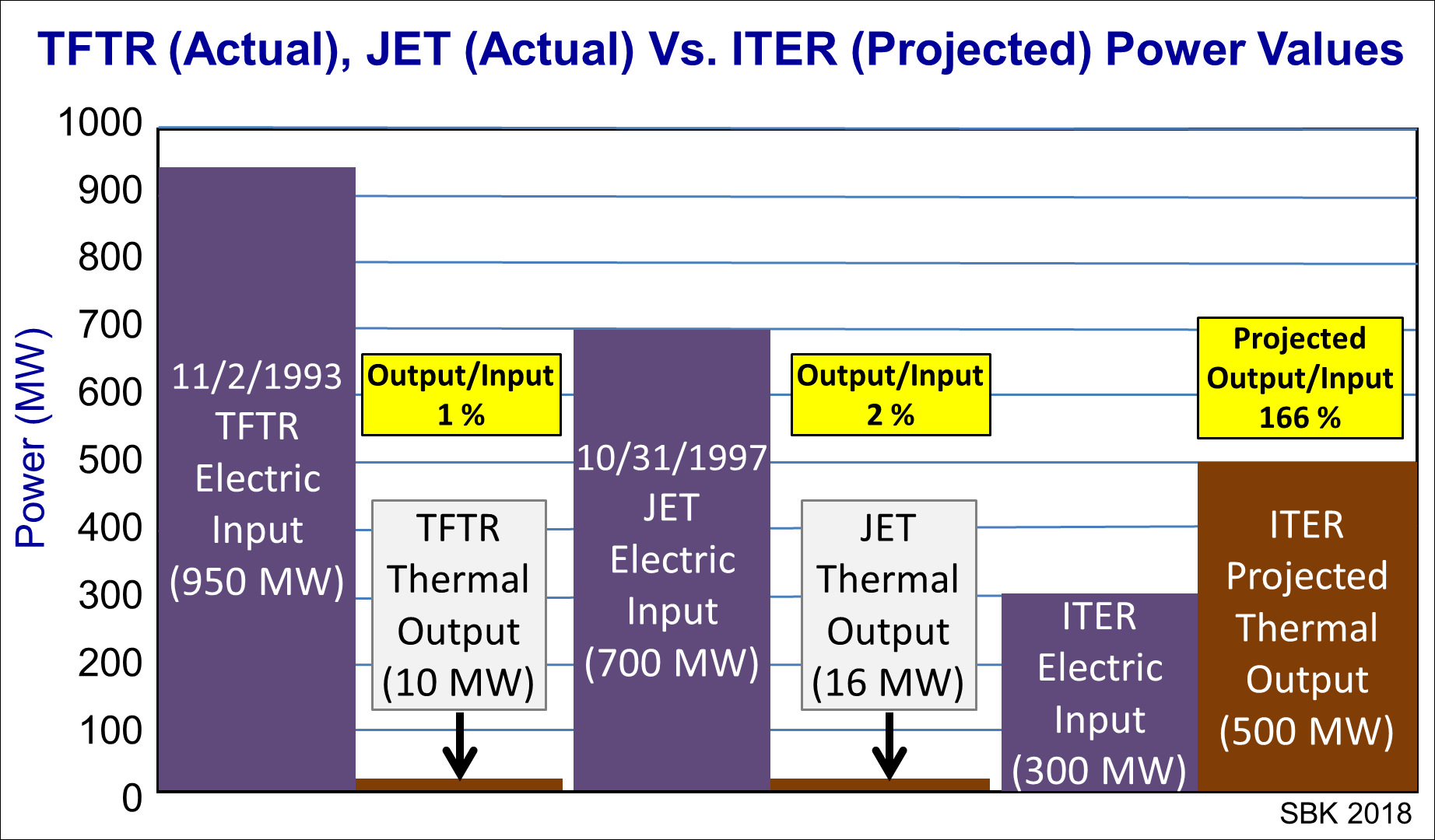
Fusion enthusiasts argue that fusion results are never measured based on comparisons to the electrical input power. That is true; and among themselves, that has always been their practice, and it is a scientifically legitimate practice. They know that fusion output results, when discussed among scientists, are compared only with the thermal power that is injected into the reaction chamber.
In public discussions, however, their representatives have rarely explained that distinction to audiences. Additionally, they have rarely told the public the real rate of power consumed by TFTR and JET, and they have been hiding the real power that is projected to be consumed by ITER. As a result, the public receives a mistaken impression of past fusion energy research progress and its future prospects.
TFTR and JET Input Power
New Energy Times has located only one reference that provides the electrical input value for TFTR. It is in the Princeton Alumni Weekly, Jan. 14, 1980. (Link) (Archive copy)
In the same way that ITER representatives today say that ITER represents the crucial link between an experimental machine and DEMO — a future prototype that is designed to generate electric power — fusion representatives said the same thing about TFTR 38 years ago: “TFTR represents the crucial link between the experimental machines now in use and future prototypes that will actually generate electric power, [and] unlike its predecessors, [TFTR] has been designed to attain reactor-level plasmas and to provide data directly applicable to designing an experimental power plant.”
Yet, as the graph above shows, the TFTR reactor lost 99% of the power it consumed. Because the phrase “reactor-level plasma” in the Princeton article was not compared with reactor power consumption, the phrase was meaningless and misleading.
On Oct. 31, 1997, JET produced the most powerful output from a fusion reactor to date. In 2014, New Energy Times sent e-mails to each of the 20 members of the U.S. Department of Energy’s Fusion Energy Sciences Advisory Committee, seeking the net power value for that JET experiment. Six of them responded. None of them, including Mark Koepke, professor of physics at West Virginia University, chair of the committee, knew the net power value. In his e-mail, Koepke said the electrical power required to operate JET was an “extraneous quantity.” Somehow, he didn’t know that JET consumed 700 MW of electrical power. Stephen Dean, the most prominent U.S. advocate for nuclear fusion, also didn’t know how much electrical power JET consumed. The JET staff, however, knew and provided that information immediately on request. A year later, the 700 MW value appeared on the EUROfusion Web site.
The public confusion about nuclear fusion output power goes back at least four decades.
Nelia Anne Davies
In 1974, two years after earning a Ph.D. from Yale University, Anne Davies went to work in the Tokamak Systems Branch of the U.S. Department of Energy. She was 31 and optimistic that her work as a plasma physicist and program manager would contribute to making fusion a practical source of clean, limitless energy for the world. A year later, she was the chief of that branch. Three years later, Davies spoke about the forthcoming TFTR reactor with journalist Edward Edelson, writing for Popular Science. Edelson highlighted the key point he learned from Davies.
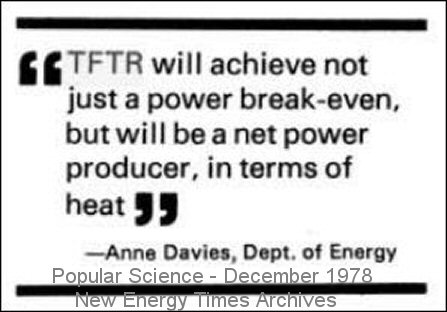
1978 public statement from N. Anne Davies
That may have been all it took to start the trend: an officer with DOE — an institution that doled out billions of dollars in research grants — sending a message to fusion researchers that it was perfectly acceptable to fuel the public’s appetite for fusion yet withhold something as important as the required reactor electrical input power. The claim was misleading to its audience but politically and financially beneficial to the fusion research community. New Energy Times spoke with Davies on March 8, 2018, and asked her, in hindsight, how the magazine might have published such a misleading quote.
“I’m pretty sure what I was talking about, in terms of heat, I meant the injected neutral beam power input versus the power out,” Davies said. “Informed by 40 years of history, I can only speculate that I either assumed the reporter understood what I meant or I actually explained it and he left it out, perhaps to shorten the article. What I am sure of is that none of us ever deliberately misled anyone. ”
New Energy Times explained to Davies that a consistent, widespread misunderstanding had taken place, as evidenced by the information about fusion research received and published by the news media, corporations and the European Commission about JET and ITER.
“I’m not surprised,” Davies said. “It’s a pretty sophisticated and complicated subject, and the people who are very knowledgeable about it can easily let slip by some of the details that are important for people to understand.”
Important details slipped by again when Davies spoke with a journalist in 1992, again in 2003, and again to members of Congress in 1993.
In 1992, after speaking with Davies and other fusion scientists, Scott Veggeberg, writing for The Scientist, was led to believe that ITER would require no external energy to fuel the fusion reaction. He left out the fact that ITER’s design requires a minimum of 300 million Watts of electrical power during peak plasma operation. He told readers, after his conversation with Davies, that TFTR “will yield about 10 megawatts of power for every 30 MW put in.” Veggeberg made no mention of the 950 MW of electricity that TFTR required, by design. Nor did he inform readers that he, or Davies, only meant to compare the thermal output power with the injected neutral beam input power.
Davies was on the panel of experts who testified on May 5, 1993, to the Committee on Science, Space, and Technology of the U.S. House of Representatives. In her oral as well as written testimony, Davies gave no indication that her reference to fusion output power didn’t account for the electric input power. Nor did she indicate that she was only comparing thermal output power to injected neutral beam input power. As was customary by fusion representatives, Davies indicated that the primary impediment to practical fusion power was the short duration of the results:
A year ago, when we were here, we reported on results from the experiments in JET. In that experiment, two megawatts of fusion power were produced in a short pulse length of about two seconds. Dr. Rebut, who’s going to appear before you later today, was the director of JET at that time, and he is now the director of ITER. At Princeton, we expect to begin the deuterium-tritium experiments in September, with the production of 10 megawatts or more of fusion power by next year.
In 2003, after speaking with several fusion scientists, Robert Stern, a reporter at the New York Times, wrote that “ITER would provide a record 500 megawatts of fusion power for at least 500 seconds. … That would meet the power needs of about 140,000 homes.” Davies told Stern that, by comparison, JET had produced only 16 MW for just 1 second. None of the experts mentioned that the given output power values for ITER or JET failed to account for the electric input or that the thermal output power was compared with only the injected neutral beam input power.
Stephen O. Dean
Stephen Dean, as Davies told New Energy Times, was her boss at DOE. For Dean, fusion has been a lifelong endeavor. After earning his master of science degree at MIT in 1962, Dean went to work for the Atomic Energy Commission (AEC) as a staff member in the Controlled Thermonuclear Research (CTR) division. In 1969, he transferred to the U.S. Naval Research Laboratory as a research physicist in the Plasma Physics Division. While there, he earned his Ph.D. in physics at the University of Maryland. In 1972, he returned to the AEC as the assistant director for magnetic confinement systems in the CTR division. He left DOE in 1979 at 43 and co-founded an advocacy group called Fusion Power Associates. Dean, like Davies, told people who were not fusion experts that fusion reactors had produced millions of Watts of thermal power without telling them that the reactors had consumed hundreds of millions of Watts of electricity or that the power gain values applied only to injected thermal input power.
In 2002, Dean wrote an article in the American Nuclear Society’s Nuclear News magazine titled “Fifty Years of U.S. Fusion Research — An Overview of Programs.” He claimed that the fundamental scientific questions of fusion research had been answered and that fusion was “certified as ready for engineering development for more than 20 years.” He blamed the failure to deliver practical fusion energy on “a weak-willed government [that] has been unwilling to manage and fund the program to accomplish its avowed practical purpose.”
Dean’s article shows a graph with a dramatically rising set of values he labeled “fusion power produced (Watts).” His text reinforced the graph:
By the mid-1990s, more than 10 MW of fusion power had been produced in TFTR and JET. The facilities were designed to sustain this power for only a few seconds, however. Obviously, for power plants, this power would need to be sustained in steady state. Hence, new facilities are required.
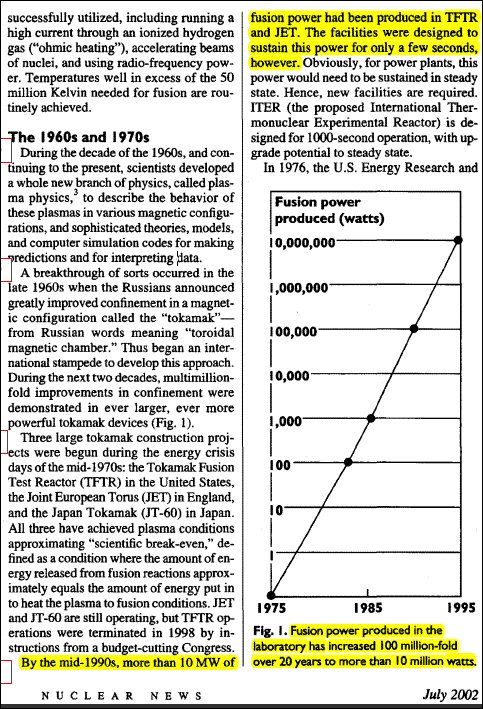
Although Dean pointed out that the limited duration of the fusion experiments was an obvious impediment to a practical fusion power plant, he omitted a more significant factor: the fact that the electrical input for the reactors was 950 MW and 700 MW, respectively.
Dean wrote this article for an audience that he assumed was not experts in fusion; he explained the terms “plasma” and “tokamak” for them. Yet he did not explain what he meant by “fusion power.” Dean reinforced his article with a quotation from a 2001 report by the National Energy Policy Development Group, which was sent to President George W. Bush:
In the early 1970s, fusion research achieved the milestone of producing 1/10 of 1 watt of fusion power, for 1/100 of a second. Today, the energy produced from fusion is 10 billion times greater and has been demonstrated in the laboratory at powers over 10 million watts in the range of a second.
The fusion promoters told the president of the United States that TFTR had produced 10 MW of “fusion power” but omitted to disclose that it was at the cost of 950 MW of electrical power. The report was distributed all over the U.S. government. Nothing in the report mentioned the 950 MW electrical input power or the fact that the value was compared only with the injected thermal input power.
New Energy Times asked Dean how he thought readers of his paper who were not fusion experts would realize that fusion reactors had not actually produced 10 MW of net thermal power.
“It’s very clear. It does not say electricity. It also says ‘in the laboratory’ and ‘for a few seconds,'” Dean wrote.
Although Davies and Dean are among the more notable public figures in fusion, many other people had roles in the public promotion of fusion, specifically ITER.
Charles C. Baker
New Energy Times interviewed Charles C. Baker, a well-known and well-respected figure in the U.S. fusion community. Baker confirmed why he and his colleagues, when talking among themselves, never talked about net reactor output. They have always known, based on the experimental data and historical context, exactly what fusion reactors have done and what they are expected to do. They knew that there was no point talking to one another of net reactor output. One must learn to walk before running; thermal plasma output power must first exceed injected thermal input power. Only then can net reactor output realistically be considered. New Energy Times asked Baker for his opinion about the widespread public misunderstanding about fusion results. Baker thought most reporting had been accurate:
My general observation over my career in fusion research (now going on 50 years) is that the reporting has been usually good. However, researchers like me probably pay less attention than we should to what appears in broad public media outlets. When inaccuracies appear, I think journalists share some of the blame because many lack scientific knowledge and they often feel they must overly simplify what they write. This does sometimes lead to inaccurate statements. It’s likely that some researchers, if indeed they even notice such statements, think that trying to correct them will be ineffective.
The researchers I have known over the years try very hard to make accurate and truthful statements to journalists. And journalists generally try to understand information outside their areas of expertise and report it accurately. Overall, in my opinion, the reporting on fusion has gotten the basic story about right. Most inaccuracies have been inadvertent.
New Energy Times asked Baker to comment on two of the many dozens of inaccurate news reports about ITER:
New York Times: “ITER will benefit from its larger size and will produce about 10 times more power than it consumes.”
Nature: “[ITER] is predicted to produce about 500 megawatts of electricity.”
“Both are examples of imprecise statements,” Baker wrote. “The NYT statement should have said ’10 times more power than injected into the plasma.’ The Nature article may indicate the writer does not recognize the difference between electricity and thermal power.”
Baker was also on the witness panel with Davies on May 5, 1993, and testified before the Committee on Science, Space, and Technology of the U.S. House of Representatives.
At the time, Baker was the U.S. ITER team leader and the associate director of the Fusion Energy Division at the Oak Ridge National Laboratory. Oak Ridge was operated then by Martin Marietta Energy Systems for the Department of Energy. After reminding Chairman Lloyd that the dogwood trees in her home state were blooming and absolutely gorgeous, Baker began his testimony:
We are about to undertake a serious effort to design an actual fusion reactor for the first time. If ITER is built, which we all hope, it will essentially be a complete model of the core of an operating fusion reactor. … For those of us who have committed our professional careers to this, it’s a culmination we have looked forward to for a long time, and we are quite excited about it and very pleased to be part of this process.
Baker explained that the U.S. effort included personnel from eight national laboratories, 10 universities, and nine industrial companies, including General Atomics, General Dynamics, Grumman, McDonnell Douglas, Rockwell International and TRW. Baker’s testimony reinforced earlier statements by Davies. The science was now understood, he said; ITER’s success was only a matter of engineering. Baker’s written testimony said that “ITER will produce 1,500 to 3,000 megawatts of fusion thermal energy.”
ITER was, of course, later scaled back to a design capacity of 500 MW gross thermal output. However, in his oral and written testimony, Baker provided no indication that his use of the phrase “fusion thermal energy” meant anything different from what it appeared to mean, net thermal power that would be generated by nuclear fusion in the ITER machine. He did not give the committee members any indication that ITER would consume hundreds of megawatts of electricity to produce the output he claimed. He did not disclose that the stated output was compared only with injected thermal input power. When I invited him to comment on the information he withheld from the committee, Baker did not respond.
Baker’s suggestion that journalists and editors are to blame doesn’t hold water: Congressional testimony, decades-old and days-old alike, shows exactly what the fusion representatives said and did not say. Their testimony is entirely consistent with what has appeared in the news media. The comparison of messages transmitted by fusion representatives and messages received by news media shows a near-identical correlation to the originating sources.
International Fusion Energy Act of 1993
At 9 a.m. on March 24, 1993, Sen. Dianne Feinstein (D-CA) called the U.S. Senate to order. After the morning prayer by Reverend Richard C. Halverson, senators began introducing new bills. Sen. J. Bennett Johnston’s (D-LA) bill was “S. 646. A bill to establish within the Department of Energy an international fusion energy program.”
By 1993, the false idea that fusion reactors had produced millions of Watts of net power was well-embedded in the public’s mind. Intrinsic to the false idea was the belief that the ultimate energy source remained out of reach only because the reactions lasted for just a few seconds. By 1993, the fusion community had learned, by experience, that nobody was likely to question them and their hidden double meaning of the phrase “fusion power.”
People familiar with electricity-producing nuclear fission reactors knew that those reactors typically produce hundreds of megawatts of net thermal power. Therefore, by comparison, 10 megawatts of net thermal power from experimental fusion reactors for just a few seconds was entirely believable. A key paragraph in Bennett’s introduction of the bill revealed his and the common mistaken perception:
ITER is expected to embody most of the features of a fusion power plant. ITER is being designed to produce 1,000 megawatts of energy, which is about half of that produced by an average-sized conventional electric power plant. The purpose of ITER is to demonstrate the scientific and technical feasibility of magnetic fusion energy and to prove that a sustained fusion reaction can be maintained at an energy level sufficient to generate electricity in commercial quantities. Today, we can produce a fusion reaction for only a second or two.
The remarks from Sen. Bill Bradley of New Jersey (home of the Princeton lab and the TFTR reactor) revealed the same misunderstanding. Moments later, Bradley asked James F. Decker, the deputy director of the DOE’s Office of Energy Research, “How much fusion power will be generated?” Decker reinforced Bradley’s misunderstanding without indicating that Decker was giving gross thermal reactor output values.
“On TFTR, the deuterium/tritium experiments, we expect to be in the 10 to 20 megawatt range. That is the amount of fusion power that we expect to be produced,” Decker said.
Decker reinforced his oral testimony with a written prepared statement. “The [TFTR] results are expected to set a world record for fusion, surpassing the performance achieved in the Joint European Torus in 1992. The additional improvement required to produce a practical fusion reactor is only a factor of about 10.”
TFTR had a thermal power output that was only 1 percent of the electrical power it consumed. The additional improvement required to develop a fusion reactor with just zero net power balance was a factor of 100 greater. A practical reactor that produced enough heat to be converted to electricity, and enough electricity to make the reactor economically feasible, was additional orders of magnitude away.
Paul-Henri Rebut, the director of the ITER design team, testified next and reinforced Decker’s message:
Since the mid-’70s, a 1,000-fold increase has been achieved in the overall performance of experimental fusion devices. We are now within a factor of five of what is required for a fusion reactor, a full fusion reactor. This factor will be gained by an increase in the size of the plasma. On November 9, 1991, a deuterium-tritium fuel mixture introduced in JET that was only 10 percent tritium produced over a megawatt of fusion power for more than 2 seconds.
An Effective Omission
By 1998, the false information about fusion results was unknowingly published in New Scientist magazine. A graph in the article gave the impression that fusion reactors had, year after year, produced enough net thermal power output — for only a few seconds — to light a bulb, to power a house and, soon, to achieve commercial power plant levels.
Nothing in the New Scientist article or graph mentioned the required electrical input for the reactors. The false message created and maintained by fusion experts was now deeply embedded in the minds of science and technology enthusiasts. The expectations of limitless clean energy fueled the hopes, enthusiasm, and dreams of people around the world; ITER was on its way. As of March 25, 2018, the ITER organization still publishes the falsehood that the JET reactor required total input power of 24 MW rather than 700 MW.
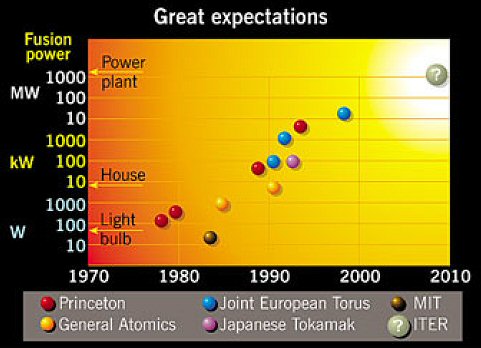
Misleading graphic from 1998 New Scientist article
Robert Lewis Hirsch
In recent years, one outlier in the fusion community, Robert Lewis Hirsch, has disagreed with the ITER project and, in general, with all magnetic confinement fusion concepts. In the 1970s, Hirsch was the director of the U.S. fusion program and assistant administrator of the U.S. Energy Research and Development Administration. After his government service, he worked as an executive with Exxon, Arco, and the Electric Power Research Institute.
Stephen O. Dean’s 2013 book Search for the Ultimate Energy Source: A History of the U.S. Fusion Energy Program includes a chapter on fusion perspectives from notable fusion scientists. Hirsch wrote that any fusion device based on the magnetic confinement design known as a tokamak reactor “will almost certainly fail to become a viable, commercial electric power system.” Hirsch lists three practical factors that reflect on his real-world experience in energy production and distribution. He asks, in the Dean book, how ITER has come so far, given the imbalance that, to him, seems so obvious. He answers his question:
One view is the belief by researchers and management that fusion research and power plant engineering could be done in a serial manner, which would allow a focus on the physics first, followed by the engineering of a commercially viable power system. In fact, that is not a correct assumption. In my commercial energy research and development experience, I repeatedly saw that engineering and market realities must be integrated and balanced early in program development, if an attractive idea is to have a chance of succeeding.
A serious, independent, unbiased commercial evaluation of the ITER tokamak approach to commercial power is lurking and will happen. The result will almost certainly be a very negative conclusion and a collapse in financial support, possibly with a condemnation of the viability of magnetic fusion. Bottom line is the following: The magnetic fusion community worldwide is likely in for a very bad experience.
Since the publication of Dean’s book, Hirsch has continued to voice his concerns. In October 2017, Physics Today published Hirsch’s article “Necessary and Sufficient Conditions for Practical Fusion Power.” Hirsch gives a warning in his conclusion:
One can only guess at why ITER continues to be built. Did the researchers ignore the engineering warnings associated with “sufficient”? Perhaps they chose to circle the wagons and hide the realities of their chosen concept. Where were the government officials who were supposedly responsible for overseeing fusion research? The media must not have been paying attention, either. When the truth regarding current tokamak fusion research is recognized, embarrassment and repercussions may well be widespread.
Hirsch saw the picture as clearly as someone so close to it could see it. What he did not see was the insidious nature of his peers’ communications to government officials and the news media. Hirsch, of course, understood what Stewart C. Prager, a former director of the Princeton Plasma Physics Laboratory, meant when he testified in 2009 before a congressional committee. Prager used the phrase “fusion power” one way and, in the same paragraph, used it to mean something completely different, without informing his congressional audience. Hirsch likely did not spend time surveying the public messages transmitted by his peers and comparing those statements with the messages received by the news media. Bigot misled journalists about ITER’s objective as recently as March 15.
Forty Years of Misinformation
Fusion representatives used three tactics to effect and maintain the false public messages about fusion research: a) publicly discussing gross thermal output power values as if they were net thermal output values, b) keeping the reactor electrical input power values out of sight, and c) before Oct. 6, 2017, generally withholding the fact that their output/input comparisons accounted only for injected thermal power input. These were, to borrow Hirsch’s words, the necessary and sufficient conditions to keep the public, the media, and elected officials misinformed.



